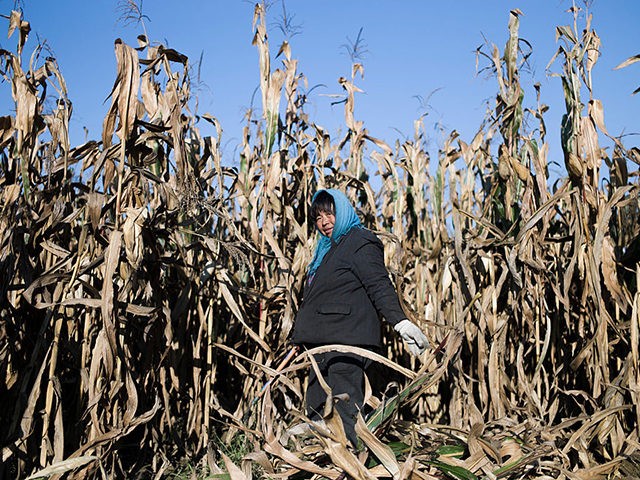China’s “corn heartland” in the northeastern province of Heilongjiang faces a shortage of farm workers for the upcoming autumn harvest, the South China Morning Post reported on Thursday.
Beijing’s push for urbanization in recent decades has resulted in hundreds of millions of people abandoning China’s countryside for urban centers in search of better-paying jobs. The migration to cities has left “a shrinking working-age population in rural villages, a phenomenon analysts call rural hollowing,” the South China Morning Post (SCMP) noted.
News of the worsening rural labor shortage comes shortly after recent typhoons and flooding devastated Heilongjiang, flattening much of the region’s corn crop and creating adverse conditions for machine harvesting in some areas. The combination of factors has increased concern over the adequacy of China’s grain supply, already in doubt following recent reports of its diminishing quality.
A farmer surnamed Xu from Acheng district in Harbin, the provincial capital of Heilongjiang, told the SCMP that locals expect lower yields for this year’s fall harvest after the recent storms flattened much of the crop, hindering the use of combines.
“Farm machines are unable to do some work, so you have to have people to do it by hand. But you cannot find enough workers,” Xu explained, adding that the labor shortage has “led to an increase in labor costs that smaller farmers often cannot afford.”
In Heilongjiang’s Longjiang county, the rural population declined by 2,568 in 2018 from the previous year, according to data from the county’s statistics bureau. The total number of urban and rural residents in Longjiang decreased by 3,085 to 580,847 in 2018.
Each of China’s three northeastern provinces — Heilongjiang, Liaoning, and Jilin — have all recorded similar population declines, according to Chinese government data. Last year, 331,300 people left the tri-province rust belt.
In late July, China Grain Reserves Cooperative (Sinograin), a state granary, banned all photo-taking devices from a storehouse unit in Heilongjiang after a video circulated on Chinese social media appearing to show stockpiles of moldy corn at the facility. The ban prompted concern that the world’s most populous nation could be suffering from a grain shortage.
Sinograin responded to the speculation in a statement on August 2, “confirming the clip showed the Zhaozhou warehouse but adding that the parent company was not trying to conceal any problems.”
Within weeks of the scandal, China made two record-setting purchases of corn from the U.S. On July 30, China made its single largest purchase of U.S. corn ever, agreeing to buy 1.937 million tons of U.S. corn. The U.S. Department of Agriculture (USDA) confirmed the sale, saying it “topped the previous biggest deal to China of 1.762 million tons” reported just two weeks prior. The July 30 sale was also “the third-largest deal for corn to any destination on record,” according to the USDA.

COMMENTS
Please let us know if you're having issues with commenting.